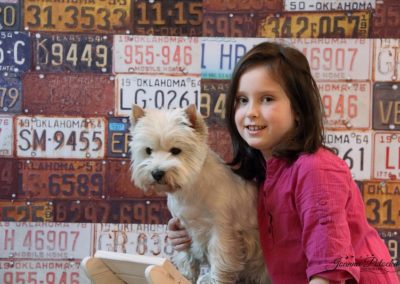BREED PATTERN
Breed pattern - a set of characteristics that a breeding animal should fulfill in order to be included in a given breed
FCI Standard nr 85
Country of Origin and Classification
Country of origin: Great Britain
Date of publication of the current breed pattern: 24.06.1987
FCI classification: group 3 - terriers, section 2 - small terriers. Attempts at work are not required.
General appearance
Strongly built. Deep chest and far back reaching the last ribs. Straight back. Strong forelegs, hind legs are muscular, which clearly affects mobility and energetic gait.
Behavior and Character
Small, vigorous, active, endowed with some self-love, simple in dealing, a little tricky. Lively, cheerful, brave, arbitrary, but cordial.
Head
The length of the skull, measured from the occipital tumor to the eyes, is slightly larger than the length of the muzzle. The head is covered with thick hair, kept at a right angle or slightly smaller to the axis of the neck, it should not be worn as if it was stretched forward. Skull slightly arched. The leading party should have a soft outline. It narrows only slightly from the base of the ears towards the eyes. The marked stop is made of prominent supraorbital arches and a slight depression between the eyes.
Viscerocranium
Black nose truffle, quite large, nothing protrudes too far and fits the whole.
Muzzle
It narrows gradually from the eyes to the tip of the nose, is not sunken, does not break sharply under the eyes, where it has its volume.
Toothing
The jaw is strong, the same length and width, because the fangs are significantly spaced, which affects the breed's wicked expression. For a dog of this size, the teeth are strong and large, in scissor bite, that is, the incisors of the jaw cover the incisors of the jaw with close contact and are positioned vertically.
Eyes
Set wide apart, medium in size, they should not be round as dark as possible. Slightly sunken under generous eyebrows, with a lively, intelligent expression and penetrating gaze. Light eyes are a very serious drawback.
Ears
Small, standing with pointed tips. They cannot be too sideways apart or too close together. They are covered with short and smooth (velvet) hair, which does not require shortening. Ears should not be covered with long, fringed hair at the top. Wide with rounded tips, large, with thick cartilage, as well as ears with abundant hair, are highly undesirable.
Neck
Long enough to lift the head properly, muscular, gradually expands at the base and blends into the obliquely arranged shoulder blades.
Torso
Compact. Straight back. Loins: Broad and strong. The chest is deep, the ribs well arched in their upper part, they become slightly flattened on the sides
Back ribs (supposed) are long and the distance between the last and the hips (weakness) is short. This does not affect freedom of movement.
Tail
12.5-15 cm long, covered with hard hair, without fringes, as straight as possible, kept upright, cannot be curled over the back. The long tail is defective and can never be shortened.
Limbs
Forelegs short and muscular, straight, covered with short, rough and dense fur. Shoulders set obliquely, broad, close to the chest.
The shoulder (shoulder) joint is clearly extended forward (prominent forechest). The elbows are positioned so as to allow free movement of the forelegs, moving parallel to the torso axis. Hindlegs viewed from above, muscular and broad, entirely short with strong tendons. Thighs strongly muscled, not too wide apart. The joints are well angulated and well positioned under the torso. When the dog is standing or moving, the heels are fairly close together. Vertical or weak hocks are a serious drawback. forelegs are larger than hindlegs. Round, proportional, strong with thick pads. The paws are covered with hard, short fur. The pads and nails should be black.
Motion
It should be efficient and free, and the legs, starting from the shoulder blades, put straight forward. The hind legs are flexible in the ankles and knees and dynamically follow the forelegs. Hocks joint under the torso to give impulse (pushing). Stiff gaits and cow's posture are highly undesirable.
Hair Cover
Two types of hair. The ground cover is about 5 cm long, hard, with no trace of curling. Rare coat is defective. The undercoat is short, soft and dense. White coat.
Height
Height at the withers about 28 cm.
Defects
Any deviations from the above standard are treated as defects and evaluated according to the degree of deviation.
Warning!
Males must have two normally developed testicles located in the scrotum.
Source
E.Chwalibóg, „Grupa III. Teriery. Wzorce ras”, Warszawa 2000r, Klub Teriera przy ZG ZKWP
Westies Besties
Small Westie with his funny expression on his mouth and strongly marked self-awareness is a unique dog. Originally used for hunting weasels and foxes, today it is primarily a friendly companion dog. In family life he is a perfect companion for both children and adults
Dog shows of our pets

Contact us
If you have any questions or would like to buy a dog, please contact us by phone or email. (For English speakers: Before calling us please write an email or private message on Facebook)
Phone number
+48 604 414 052
westiesbesties@op.pl




